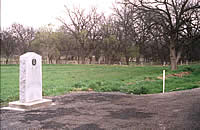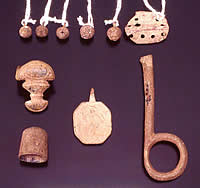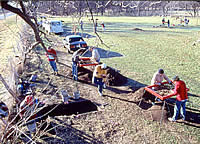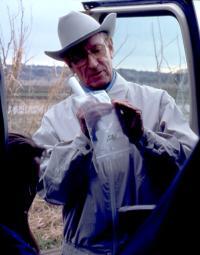
The 1936 Texas State Centennial marker
had for years been located to the west of the mission
site near Menard, the true location not being known
at the time the marker was installed. Following discovery
of the mission site in 1994, the Texas Department of
Transportation moved the marker to its present location,
immediately beside the mission site. In the background
is seen the thick growth of alfalfa that prevented earlier
archeologists, such as Kathleen Gilmore and Shawn Carlson,
from finding the site.
Click images to enlarge
|

Texas A&M historical archeologist
Dr. Shawn Carlson examines Spanish pottery that helped
confirm that Mission San Sabá finally had been
found.
|
|
The reality is that the mission was a squalid little
place where the priests and other residents were living
in cramped, primitive quarters.
|

Metal objects from mission include
several globular buttons, bridle clamp, thimble, a religious
medallion (center), and candlewick trimmer/snuffer handle.
|
|
Massacre or Victory?
Spain and Mexico viewed the attack on Mission
San Sabá as an atrocity. This is certainly the view
that has come down to us through history books, almost all
of which refer to the attack as a "massacre." From
the standpoint of the Native American groups involved on the
winning side of the mission attack, it was one of the few
major victories they could claim over the Spanish foreigners
who invaded their land.
In addition to being angered by Spanish intrusion,
the Comanches and their allies detested the Apache. This animosity
was the result of earlier competition for land and resources,
at which the aggressive Apache had been very successful. As
the Comanche swept into Texas from the northwest, they found
willing allies in the Wichita, Tonkawa, and other tribes who
had been bullied by the Apache. When the Spaniards chose to
establish a mission for the Apache at San Sabá, they
automatically became the enemies of the Comanche and other
"Norteño" groups who detested the Apache.
The destruction of the mission and subsequent
harassment of Spaniards still occupying the Presidio San Sabá
were major reasons for the eventual withdrawal of the Spaniards
out of Texas, and guaranteed Indian domination of much of
the region for another 50 to 100 years. Strategically, the
attack on Mission San Sabá was as successful as the
Spanish decision to establish the mission was a failure.
"A Triumph For All Who Seek"
Mark Wolf, Kay Hindes, and I realize we were
very fortunate to have found Mission San Sabá. Many
very capable people had previously searched long and hard
but had failed to find the mission. We had two advantages
going for us. First, Hindes had an open mind about what John
Warren Hunter had to say. It is a lesson to all of us that
"no stone should be left unturned" in the search
for elusive sites like San Sabá. Secondly, it was just
a plain stroke of good luck that we happened along right after
Judge Lyckman had plowed his alfalfa field. There was a window
of just a few weeks when the ground was visible and we could
see the artifacts that told of the mission's existence. Had
we come along the month before, or the month after, we would
have joined the long list of searchers who walked right over
the mission without knowing it, simply because the ground
was covered by alfalfa.
In reviewing what was found at the mission during
our various excavations there, it is remarkable there was
so little left. The Indians set the place on fire and burned
it down in 1758. They carried away with them many desirable
items. We can imagine that bead necklaces, religious medallions,
knives, hatchets, metal cooking pots, and the like would have
been valued by the Indians and probably were hauled off by
them after the attack. Then, Spanish soldiers came in shortly
after the attack and salvaged what they could from the ruins.
We can only guess how many people visited the
site between 1758 and the early 1900's when the site's whereabouts
were still generally known. We know from a letter written
in 1901 by J. J. Callan, a resident of Menard, that a substantial
collection of artifacts from the mission was sent to the State
Fair in Dallas. This collection has never been relocated.
In view of all these looting, salvage, and collecting activities
over the years, it is a wonder that we recovered ANY artifacts
from the mission. Yet, with careful recovery, we were able
to find, for example, a scatter of musket balls around the
church that supported the story of Juan Leal and the other
survivors who had sought refuge there during the attack.
The wonderful mural of the attack on Mission
San Sabá Mission gave us a good idea of what the little
mission looked like. Archeological investigations revealed
a pattern of post stains that confirmed the mural depiction.
The stories about the attack and its depiction in the mural
are very dramatic, and we know that the events that unfolded
at the mission were important in Texas history. But the reality
is that the mission was a squalid little place where the priests
and other residents were living in cramped, primitive quarters.
Standing where the church once stood, and thinking about the
musketballs scattered all around, one gets a feel for how
desperate the situation was for Juan Leal and the others who
were trying to survive inside on that March day back in 1758.
The archeology makes it real and brings those days back to
life.
We also feel lucky to have found the site
when we did. An elderly man from the Menard area who came
out to visit the 1997 excavations remembered that his grandfather
used to farm the field containing the mission. The man said
his grandfather, who used a mule-drawn plow, did not like
to work in this particular field because he was always hitting
"big burned stumps," which he had to stop and remove.
We believe that the "stumps" were actually the bases
of wooden posts from the mission stockade and other structures.
By 1993, mechanized farming activities
had eliminated all but the lowest remnants of the posts that
had burned down into the ground—at the most only 2 to
4 inches of the post stains remained. Plows were cutting down
into pit features, such as the pit where the sundial was found,
and dragging up bones, charcoal, and artifacts. I believe
that another 10 or 20 years of farming would have completely
destroyed the post stains and the features. Had we found the
site in the year 2020, the artifacts would still be there,
but we would not be able to trace the footprint of the mission,
its size and layout, because the post stains would be gone.
The San Sabá Mission site can be viewed
by traveling three miles east on FM 2092 out of Menard. The
1936 Texas Centennial Marker is along the highway immediately
beside the alfalfa field. As Robert Weddle wrote in 1996:
"The rediscovery of Mission Santa Cruz de San Sabá
represents a triumph for all who seek."
|
|
|
|
Strategically, the attack on Mission San Sabá
was as successful as the Spanish decision to establish
the mission and its presidio was a failure.
|

Test excavations along this fence row showed that this
area of the site contained the least damaged deposits
because of the protection afforded by the fence (plowing
stopped short of the fence). |

Texas Tech student Russ Shortes works
on the continuing analysis of the materials recovered
during the 1997 excavation of Mission San Sabá.
|

Historian Robert Weddle examining
Spanish artifacts found at the mission site.
|
|